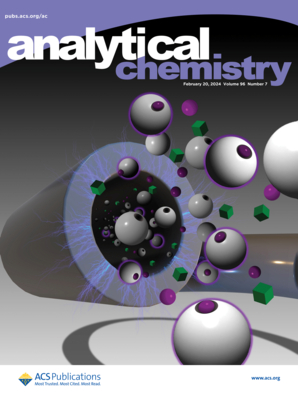In Vivo Identification and Spatial Distribution of Crown Gall Disease Biomarkers in Grapevine.
IF 6.7
1区 化学
Q1 CHEMISTRY, ANALYTICAL
引用次数: 0
Abstract
Grapevine crown gall is caused by the tumorigenic bacterium Allorhizobium vitis. The fight against this disease is a major challenge in viticulture since this pathogen can systemically colonize the plant host, persisting in vineyards once infected. Understanding the dynamics of the plant-pathogen relationship not only improves our knowledge of plant biology but also could lead to innovative strategies for sustainable agricultural practices. In this way, this study aimed to gain insights into metabolic changes occurring in the tumor induced by A. vitis, using two techniques, Water-Assisted Laser Desorption/Ionization Mass Spectrometry (WALDI) and Matrix-Assisted Laser Desorption/Ionization Mass Spectrometry Imaging (MALDI MSI). We highlighted compounds such as phenolics alongside specific lipids acting as stress signaling regulators. Moreover, vitopine, produced after plant cell transformation by A. vitis and exclusively found in infected plants, was successfully identified by real time detection by SpiderMass and localized for the first time through MSI. We illustrate here the effectiveness of SpiderMass and MSI in identifying biomarkers of grapevine crown gall, enhancing our understanding of plant responses to bacterial infection. These techniques allow for real-time analysis and spatial distribution mapping of metabolites, paving the way for future research and potential applications in diagnostics.葡萄冠瘿病生物标志物的体内鉴定及空间分布。
葡萄冠瘿是由致瘤性细菌葡萄异根菌引起的。与这种疾病的斗争是葡萄栽培的主要挑战,因为这种病原体可以系统地定植植物宿主,一旦感染就会在葡萄园中持续存在。了解植物-病原体关系的动态不仅提高了我们对植物生物学的认识,而且还可能导致可持续农业实践的创新策略。因此,本研究旨在通过水辅助激光解吸/电离质谱(WALDI)和基质辅助激光解吸/电离质谱成像(MALDI MSI)两种技术,深入了解葡萄球菌诱导的肿瘤中发生的代谢变化。我们强调了化合物,如酚类物质和特定的脂质作为应激信号调节器。此外,vitopine是葡萄球菌转化植物细胞后产生的,只存在于被感染的植物中,通过SpiderMass实时检测成功鉴定,并首次通过MSI定位。我们在此展示了SpiderMass和MSI在鉴定葡萄冠瘿生物标志物方面的有效性,增强了我们对植物对细菌感染反应的理解。这些技术允许对代谢物进行实时分析和空间分布测绘,为未来的研究和诊断中的潜在应用铺平了道路。
本文章由计算机程序翻译,如有差异,请以英文原文为准。
求助全文
约1分钟内获得全文
求助全文
来源期刊

Analytical Chemistry
化学-分析化学
CiteScore
12.10
自引率
12.20%
发文量
1949
审稿时长
1.4 months
期刊介绍:
Analytical Chemistry, a peer-reviewed research journal, focuses on disseminating new and original knowledge across all branches of analytical chemistry. Fundamental articles may explore general principles of chemical measurement science and need not directly address existing or potential analytical methodology. They can be entirely theoretical or report experimental results. Contributions may cover various phases of analytical operations, including sampling, bioanalysis, electrochemistry, mass spectrometry, microscale and nanoscale systems, environmental analysis, separations, spectroscopy, chemical reactions and selectivity, instrumentation, imaging, surface analysis, and data processing. Papers discussing known analytical methods should present a significant, original application of the method, a notable improvement, or results on an important analyte.
 求助内容:
求助内容: 应助结果提醒方式:
应助结果提醒方式:


